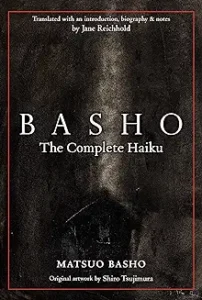Basho: The Complete Haiku transl. by Jane Reichhold 2008
Basho, like Walter Benjamin, is one of those writers whose name seems to pop up all over the place. From poetry to books about walking, from books about Japan to those about Buddhism, Basho seems to be everywhere. His “Narrow Road to the Far North” a prose poem travel book about his 1500 mile exploration of the interior of Japan’s Honshu Island is his most referenced work, but he is also famous as the ‘saint of Haiku”, the five-seven-five, 17 syllable poetic form that he radically changed when writing in the 17th C.
Born in 1644, he lived for 50 years moving from his home town of Ueno in Iga Province west of Kyoto to Edo/Tokyo, Kyoto, and the countryside. Along the way he studied to become a Zen Buddhist monk and often dressed and cut his hair short in that style. He is famous for having radically changed and energized the haiku form by writing about common objects using common language. The translator of these poems characterized his skill as ‘capturing both the momentary and the eternal is a small form.” His guiding principles were the lyruc beauty of Chinese poets, the spirit of Zen Buddhism, the sensibility of wabi (a philosophy that values the simplicity and beauty of simple objects), the poetic life, and romantic live.
This volume is the first English translation of all Basho’s haikus, all 1011 of them and is a bit overwhelming to manage all at one time. It is probably best read in small doses perhaps to begin or end the day. Basho calls upon the reader to ‘fill in the blanks’ writing the three lines to imply an action or situation which the reader has to complete. The poems are often banal but there are jewels among them. Here’s #812: “come closer/to look at the vase/of plum and camilla”, and here’s #175: “even in snow/the moon face flower does not wither/in the sun.”
The translator, Jane Reichhold died in 2016, taking her life at the age of 76 on a beach on the northern California coast when she was suffering from the unremitting pain of fibromyalgia. She was a much beloved member of the poetry community and a popularizer of the haiku form in America. Here’s one of her own works: romance/in a humdrum life/the orchid
I must admit that I didn’t read all 1011 haikus, but I read enough of them to see the beauty of Basho’s work and the enormous skill in its translation.



